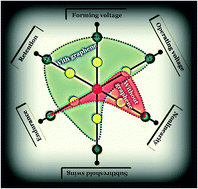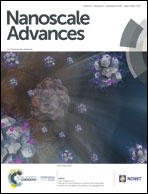Transformation of threshold volatile switching to quantum point contact originated nonvolatile switching in graphene interface controlled memory devices†
Abstract
Resistive switching devices based on binary transition metal oxides have been widely investigated. However, these devices invariably manifest threshold switching characteristics when the active metal electrode is silver, the dielectric layer is hafnium oxide and platinum is used as the bottom electrode, and have a relatively low compliance current (<100 μA). Here we developed a way to transform an Ag-based hafnium oxide selector into quantum-contact originated memory with a low compliance current, in which a graphene interface barrier layer is inserted between the silver electrode and hafnium oxide layer. Devices with structure Ag/HfOx/Pt acts as a bipolar selector with a high selectivity of >108 and sub-threshold swing of ∼1 mV dec−1. After introducing a graphene interface barrier, high stress dependent (forming at +3 V) formation of localized conducting filaments embodies stable nonvolatile memory characteristics with low set/reset voltages (<±1.0 V), low reset power (6 μW) and multi-level potential. Grain boundaries of the graphene interface control the type of switching in the devices. A good barrier can switch the Ag-based volatile selector into Ag-based nonvolatile memory.



 Please wait while we load your content...
Please wait while we load your content...